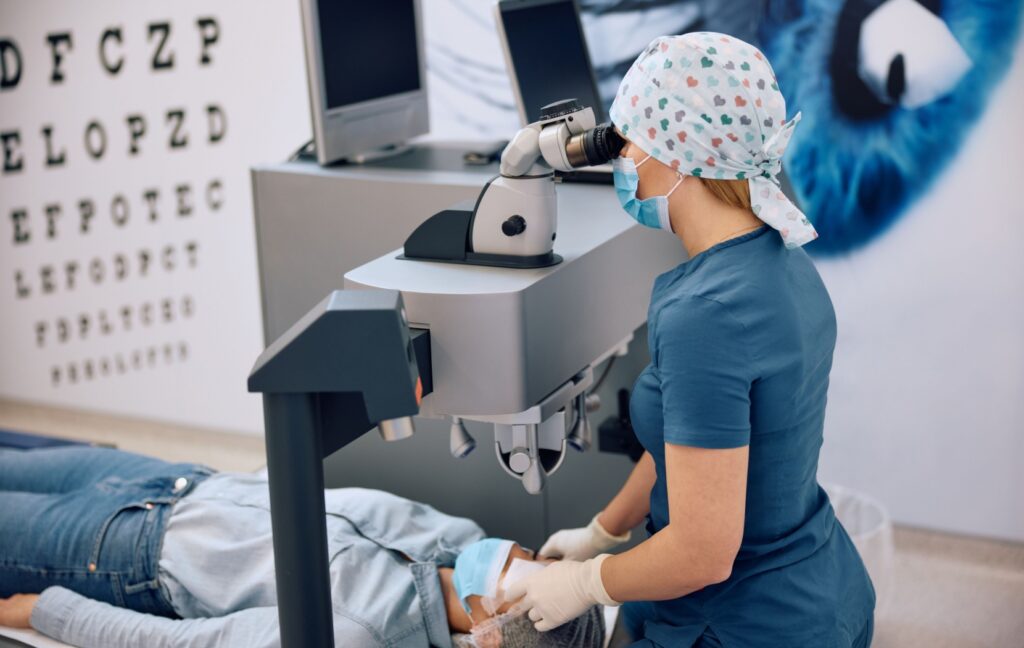Farsightedness, also known as hyperopia, can make daily life frustrating. Reading the fine print, enjoying a good novel, or even scrolling through your phone can become difficult when objects up close look blurry or distorted.
Luckily, farsightedness can be managed in several ways, including prescription eyeglasses, contact lenses, and even eye surgery.
What Is Farsightedness?
Farsightedness, or hyperopia, is a refractive error in which your eyes struggle to focus on nearby objects. It happens when the eyeball is too short or the cornea (the outermost layer of the eye) has too little curvature, making light focus behind the retina instead of directly on it.
Symptoms of farsightedness can include:
- Difficulty seeing clear objects up close
- Eye strain or discomfort when reading or using screens
- Headaches after tasks requiring focus on near objects
- Squinting to improve focus
Hyperopia can affect both children and adults, though it often becomes more noticeable with age. If any of these symptoms seem familiar to you, consult your optometrist immediately.
Non-Surgical Options for Correcting Farsightedness
The good news is that farsightedness can be easily managed with various correction methods tailored to your specific needs. Here are some common methods used to manage hyperopia.
1. Eyeglasses
Eyeglasses are the quickest and most straightforward option.
Glasses designed for hyperopia work by using convex lenses to bend light rays so they focus properly on the retina. Eyeglasses are great for people who prefer non-invasive options, need temporary correction, or want minimal maintenance.
Prescription eyeglasses are great because they are:
- Affordable and accessible
- Easy to use
- Customizable to suit your vision needs and personal style
Whether you need single-vision lenses for daily wear or progressive lenses for both near and distant correction, eyeglasses offer versatility.
2. Contact Lenses
For those who prefer a glasses-free look, contact lenses are a popular alternative.
For farsightedness, convex corrective contact lenses reshape how light enters your eyes, bringing images into focus. Contact lenses work well for people with active lifestyles or those seeking a discreet option.
The benefits of contact lenses are that they:
- Provide a natural field of vision without frames
- Are lightweight and nearly invisible
- Are available in daily, bi-weekly, or monthly varieties
Contact lenses require proper hygiene to avoid infections, but for many people, the flexibility they offer is worth it.

Surgical Options for Farsightedness
1. LASIK Surgery
If you’re ready to leave glasses and contacts behind, LASIK surgery is a widely used option for long-term vision correction.
LASIK (Laser-Assisted in Situ Keratomileusis) uses a laser to reshape your cornea, allowing light to focus correctly on your retina. Adults with stable prescriptions and no underlying eye health issues can be candidates for LASIK surgeries.
The benefits of LASIK can include:
- Permanent vision correction
- Quick recovery (typically within 1-2 days)
- Minimal post-surgery care
LASIK is a well-established procedure with potential benefits and risks, and it may not be suitable for everyone. An eye care professional can assess whether this option aligns with your vision needs.
2. PRK Surgery
Photorefractive keratectomy (PRK) is another surgical option, particularly for patients who may not qualify for LASIK. PRK reshapes the cornea by removing its outer layer before using lasers to correct refractive errors. The outer layer then regenerates over time. PRK is good for individuals with thin corneas or those participating in high-impact sports.
Here are some of the potential benefits of PRK:
- Ideal for patients with specific vision profiles
- No risk of corneal flap complications (as seen in LASIK)
- Long-lasting results
PRK typically has a longer recovery time than LASIK, but many patients achieve similar vision improvements.
3. Refractive Lens Exchange (RLE)
For severe farsightedness, refractive lens exchange is a cutting-edge surgical option. During RLE, your natural lens is replaced with an artificial intraocular lens (IOL) to help correct vision problems. RLE is a good option for older adults with presbyopia or those not suited for laser surgery.
Some of the benefits of RLE can be:
- Addresses conditions like cataracts
- Permanent improvement in vision
- Reduces dependency on glasses or contacts
RLE requires a more substantial investment but provides an alternative option for individuals with severe vision problems.
Determining the Option for You
Choosing the right farsightedness correction method for you depends on several factors:
- Your lifestyle: Active individuals may prefer contact lenses or surgery for convenience.
- Your budget: Glasses and contacts are affordable, while surgeries like LASIK or RLE require higher upfront costs.
- Your long-term goals: If you’re looking for a potentially permanent fix, surgery can offer these results.
Consulting an eye care professional is a great way to evaluate your options and create a plan tailored to your situation.
Improve Your Vision & Your Life
Farsightedness doesn’t have to hold you back. Whether you choose glasses, contacts, or surgical options, your vision can be managed to align with your goals and lifestyle.
At Total Vision, we’re here to help you get the eye health you deserve. Whether it’s farsightedness or something else, we have a variety of corrective options for you. Book your next eye exam today.



